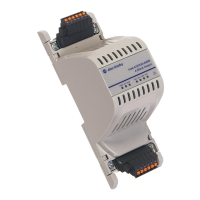206 Rockwell Automation Publication 1444-UM001D-EN-P - June 2018
Chapter 7 Configure Relays
Main Module Fault Output
Relays can also be configured to actuate on various fault conditions. Fault
conditions can be selected in addition to a voted alarm input, or independently
of (so acts only on faults) and any or all faults can be selected for notification by
the relay.
The available faults that can be detected and acted on by the dynamic
measurement module relay differ from those faults that are available to the
expansion module relays. The available faults that the main module relay can
be configured to act on are as follows:
Module Fault
The module fault is a fault reported by the main module itself on failure of any
of the following:
•Startup tests
• RAM (memory) test
• Code CRC check
•Runtime tests
• RAM (memory) test (Runtime version)
• Code CRC check (Runtime version)
• Relay drive test (tests the internal relay drive circuitry when the relay
configuration is fail-safe)
The level of the compliance requirement determines how, which, and how
frequently the runtime tests are performed. See
General Page on page 97.
Tachometer Fault
A tachometer fault condition is communicated to the main module by any of:
• The local bus from the tachometer signal conditioner expansion module
(1444-TSCX02-02RB)
• The tachometer fault status inputs (terminal connections) from the
tachometer signal conditioner expansion module (1444-TSCX02-
02RB) or other source
• The SpeekOK0/1 bits in the controller output control tag
See
Tac h omet er Pa g e on page 194 for further information on how to define
fault detection for a tachometer signal conditioner expansion module.

